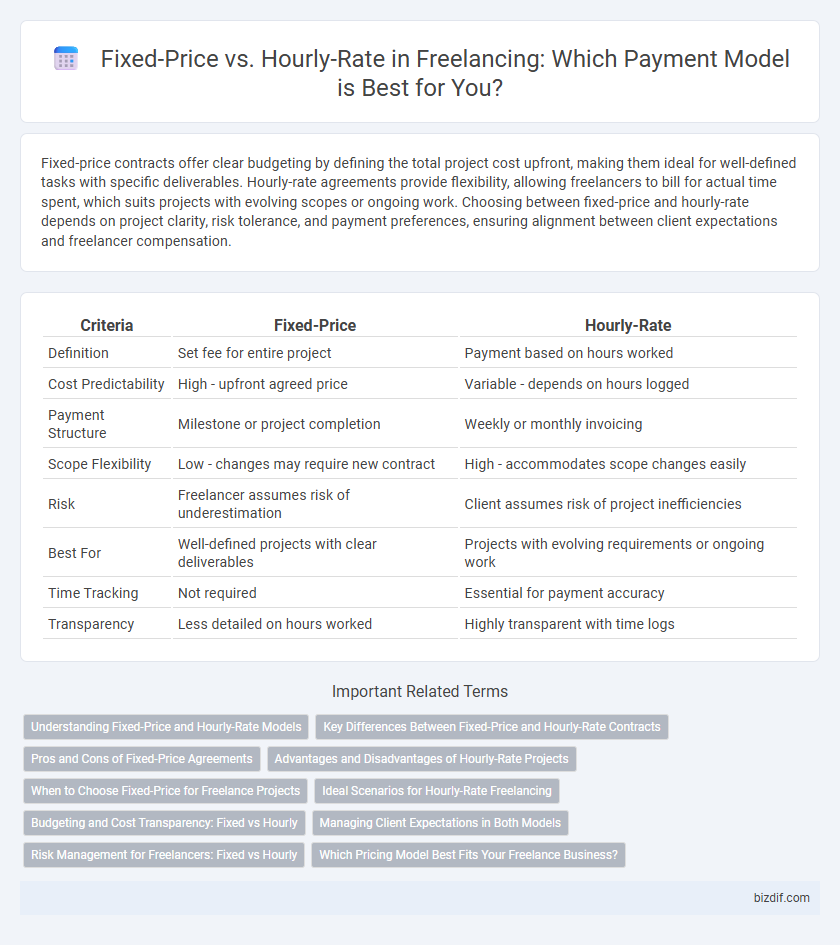Fixed-price contracts offer clear budgeting by defining the total project cost upfront, making them ideal for well-defined tasks with specific deliverables. Hourly-rate agreements provide flexibility, allowing freelancers to bill for actual time spent, which suits projects with evolving scopes or ongoing work. Choosing between fixed-price and hourly-rate depends on project clarity, risk tolerance, and payment preferences, ensuring alignment between client expectations and freelancer compensation.
Table of Comparison
| Criteria | Fixed-Price | Hourly-Rate |
|---|---|---|
| Definition | Set fee for entire project | Payment based on hours worked |
| Cost Predictability | High - upfront agreed price | Variable - depends on hours logged |
| Payment Structure | Milestone or project completion | Weekly or monthly invoicing |
| Scope Flexibility | Low - changes may require new contract | High - accommodates scope changes easily |
| Risk | Freelancer assumes risk of underestimation | Client assumes risk of project inefficiencies |
| Best For | Well-defined projects with clear deliverables | Projects with evolving requirements or ongoing work |
| Time Tracking | Not required | Essential for payment accuracy |
| Transparency | Less detailed on hours worked | Highly transparent with time logs |
Understanding Fixed-Price and Hourly-Rate Models
Fixed-price projects require freelancers to deliver agreed-upon work within a set budget, encouraging clear project scope definitions and minimizing financial uncertainty for clients. Hourly-rate models provide flexibility by billing based on actual time worked, making them suitable for ongoing or undefined tasks where scope might evolve. Understanding these models helps freelancers balance risk and reward while offering clients transparent payment structures tailored to project needs.
Key Differences Between Fixed-Price and Hourly-Rate Contracts
Fixed-price contracts offer a set payment for the entire project, providing budget certainty and clear deliverables, ideal for well-defined tasks with specific scopes. Hourly-rate contracts bill clients based on actual hours worked, offering flexibility for projects with evolving requirements and fostering continuous communication between freelancers and clients. Understanding these key differences helps freelancers select the best contract type to balance risk, compensation, and project management efficiency.
Pros and Cons of Fixed-Price Agreements
Fixed-price agreements offer clear budget expectations and minimize financial risk for clients, making them ideal for projects with well-defined scopes and deliverables. However, they pose risks for freelancers if project requirements change unexpectedly or if time investment exceeds initial estimates, potentially reducing profitability. This model demands precise project planning and scope management to avoid scope creep and ensure fair compensation.
Advantages and Disadvantages of Hourly-Rate Projects
Hourly-rate projects offer flexibility, allowing freelancers to be compensated for the actual time invested, which is beneficial for tasks with uncertain scopes or frequent changes. This payment model promotes transparency and can incentivize thorough and careful work, though it may also lead to fluctuating income and potential disputes over hours logged. Clients might appreciate the adaptability, but they risk higher costs if the project timeline extends beyond initial expectations.
When to Choose Fixed-Price for Freelance Projects
Fixed-price projects are ideal when the scope and deliverables are clearly defined, allowing freelancers to set a precise budget and timeline. This pricing model works best for tasks with specific outcomes, such as website design or content creation, where changes are minimal. Choosing fixed-price contracts helps manage client expectations and reduces disputes by locking in cost and deadlines upfront.
Ideal Scenarios for Hourly-Rate Freelancing
Hourly-rate freelancing excels in projects with evolving scopes, allowing flexibility to accommodate changing client requirements and ongoing feedback. It suits tasks requiring continuous collaboration, like software development or consulting, where the workload varies and precise time tracking ensures fair compensation. This model also benefits freelancers in long-term engagements or maintenance work, ensuring they are paid accurately for every hour invested.
Budgeting and Cost Transparency: Fixed vs Hourly
Fixed-price contracts offer clear budget boundaries, ensuring clients know the total project cost upfront, which enhances cost transparency and simplifies financial planning. Hourly-rate agreements provide flexibility for evolving project scopes but may introduce budgeting uncertainties due to variable hours worked. Choosing between fixed-price and hourly-rate models depends on the project's complexity, scope stability, and the client's preference for cost predictability versus adaptability.
Managing Client Expectations in Both Models
Managing client expectations in fixed-price freelancing requires clear project scopes and defined deliverables to prevent scope creep and ensure timely delivery within budget. In hourly-rate contracts, transparent tracking of hours and regular updates are essential to justify costs and maintain trust. Effective communication of milestones and potential changes enhances satisfaction and reduces disputes in both pricing models.
Risk Management for Freelancers: Fixed vs Hourly
Fixed-price contracts provide freelancers with predictable income and clear project scopes, reducing financial uncertainty but increasing the risk of scope creep and unpaid extra work. Hourly-rate agreements offer compensation proportional to time spent, minimizing the risk of underpayment but potentially leading to income fluctuations and client disputes over hours billed. Effective risk management involves selecting the contract type that aligns with project complexity, client reliability, and personal cash flow needs to balance revenue stability and workload control.
Which Pricing Model Best Fits Your Freelance Business?
Choosing between fixed-price and hourly-rate models depends on project scope, client preferences, and risk tolerance. Fixed-price contracts suit well-defined projects with clear deliverables, providing predictable income and minimizing scope creep, while hourly rates offer flexibility for ongoing or evolving work, ensuring fair compensation for time invested. Evaluating your expertise, project complexity, and client communication style helps determine the most efficient pricing strategy for sustainable freelance growth.
Fixed-price vs Hourly-rate Infographic

 bizdif.com
bizdif.com